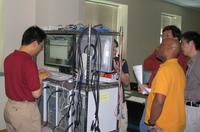Highlights of our Work
2024 | 2023 | 2022 | 2021 | 2020 | 2019 | 2018 | 2017 | 2016 | 2015 | 2014 | 2013 | 2012 | 2011 | 2010 | 2009 | 2008 | 2007 | 2006 | 2005 | 2004 | 2003 | 2002 | 2001
For hard-working scientists, the task of maintaining a single desktop
computer is an unwelcome distraction.
But what if your work requires the power of ten or a hundred machines?
Our recent series of workshops
(Sep 2005,
Nov 2005,
Mar 2006, and
Apr 2006)
has given nearly one hundred participants
hands-on experience
installing and using
low-cost Linux clusters.
Students were taught to eliminate many sources of complexity, such as
hard drives, and to automate what remained with cluster management
software and a queueing system.
Lectures
on cluster design stressed the importance of knowing
which applications would be run and choosing cost-effective
hardware to meet those specific needs,
as well as less-obvious aspects of cluster
acquisition such as electrical power, cooling, and the purchasing process.
After assembling and installing small four-node clusters, students ran both
the molecular dynamics program NAMD
and a more typical parallel application that they compiled from scratch.
Most participants were motivated by concrete plans to build clusters
for their own groups in the near future and felt better-equipped to
do so following their experience.




